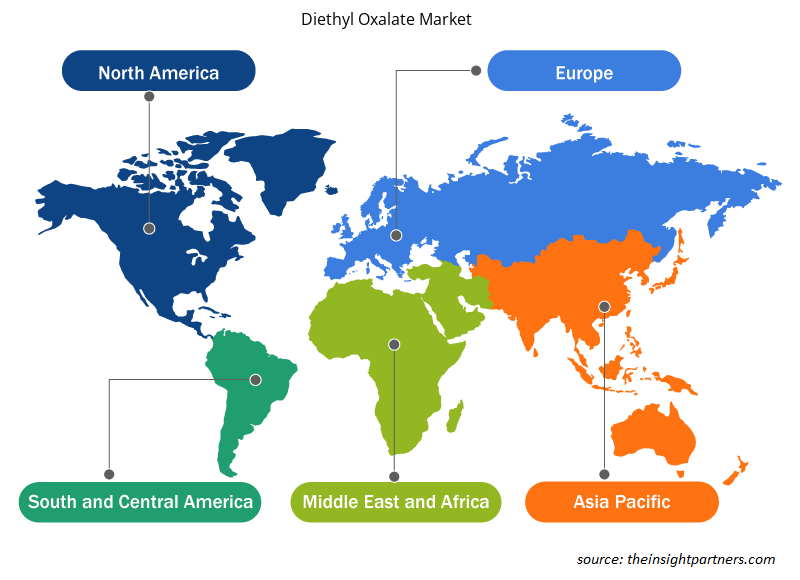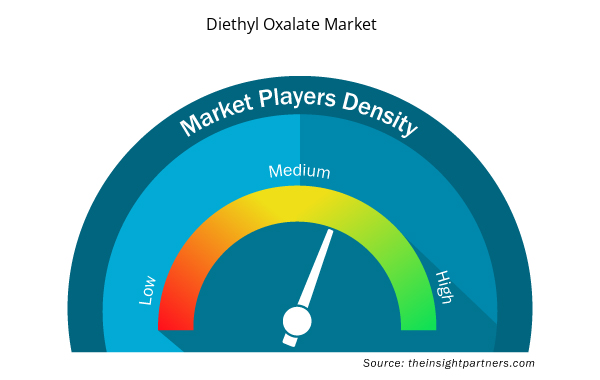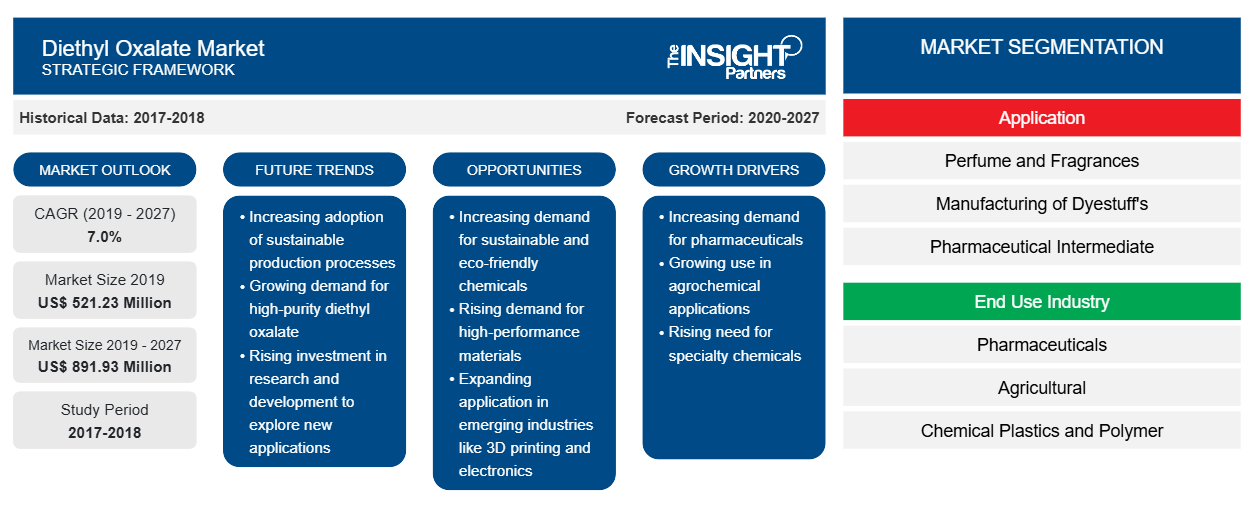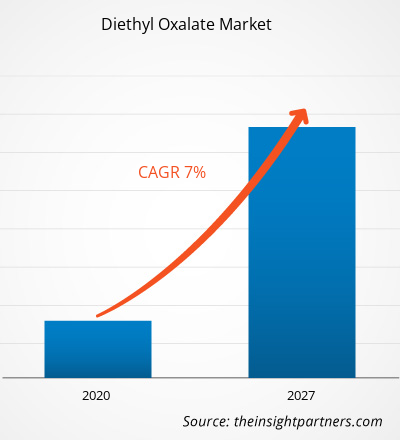디에틸 옥살레이트 시장 규모는 2019년에 5억 2,123만 달러였으며 2027년까지 8억 9,193만 달러에 도달할 것으로 예상됩니다. 2020년에서 2027년까지 연평균 성장률 7.0%로 성장할 것으로 예상됩니다.
디에틸 옥살레이트는 에탄올과 일산화탄소 화합물에서 합성된 흰색 고체 화합물로 알려져 있으며, 분자식은 C6H10O4입니다. 디에틸 옥살레이트는 여러 제조 공정의 중간체 또는 원료로 사용됩니다. 디에틸 옥살레이트는 에탄디오산 및 옥살산 디에틸 에스테르라고도 합니다. 디에틸 옥살레이트는 분말과 액체 형태로 제공됩니다. 이 화합물은 주로 페노바르비탈과 수많은 염료 생산의 원료 또는 중간체로 사용됩니다. 또한 니트로셀룰로오스 래커와 다양한 화학 합성 공정에서 천연 및 합성 수지의 용매로 사용됩니다. 또한 활성 제약 성분의 합성에서 화학 중간체로 사용됩니다. 디에틸 옥살레이트는 주로 염료 감응형 태양 전지를 기반으로 하는 비용 효율적인 첨가제로도 사용할 수 있습니다.
북미 지역에서 연구된 시장은 예측 기간 동안 7.8%의 가장 높은 CAGR로 성장할 것으로 예상됩니다. 이 지역에서 연구된 시장의 성장은 주로 디에틸 옥살레이트를 생산하는 데 필요한 원자재의 방대하고 쉬운 가용성과 저명한 글로벌 시장 참여자의 존재에 기인합니다. 북미에서 디에틸 옥살레이트는 활성 제약 성분의 제조에 많이 사용됩니다. 이는 약물 제품의 생물학적으로 활성인 성분을 지칭하는 데 사용되는 용어입니다. 이들은 제약 약물 제품의 제조에 사용되는 중요한 화합물입니다. 북미는 활성 제약 성분의 주요 시장 중 하나로 알려져 있으며 앞으로 몇 년 동안 그 거점을 유지할 것으로 예상됩니다. 의료 부문에서 증가하는 정부 이니셔티브, 생물학 분야의 혁신, 암 및 연령 관련 질병의 발생률 증가는 북미에서 활성 제약 성분의 성장을 증폭시킵니다. 이 지역의 활성 제약 성분에 대한 수요는 질병 발생률 증가와 노인 인구 증가로 인해 앞으로 증가할 것으로 추산됩니다.
귀하의 요구 사항에 맞게 이 보고서를 사용자 정의하세요
이 보고서의 일부 또는 국가 수준 분석, Excel 데이터 팩을 포함하여 모든 보고서에 대한 사용자 정의를 무료로 받을 수 있으며 신생 기업 및 대학을 위한 훌륭한 혜택과 할인 혜택을 이용할 수 있습니다.
- 이 보고서의 주요 시장 동향을 알아보세요.이 무료 샘플에는 시장 동향부터 추정 및 예측까지 다양한 데이터 분석이 포함됩니다.
COVID-19가 디에틸 옥살레이트 시장에 미치는 영향
2021년 7월 현재 미국, 인도, 브라질, 러시아, 스페인, 프랑스, 영국, 터키, 이탈리아는 확진자와 사망자 수 측면에서 가장 큰 영향을 받은 국가입니다. COVID-19는 봉쇄, 여행 금지, 사업 중단으로 인해 여러 국가의 경제와 여러 산업에 영향을 미치고 있습니다. 다양한 제조 공장과 공장의 폐쇄도 글로벌 공급망에 영향을 미쳤으며, 글로벌 시장에서의 제조, 배송 일정, 상품 판매에도 부정적인 영향을 미쳤습니다. 또한 유럽, 아시아 태평양, 북미 국가가 추가로 부과한 글로벌 여행 금지도 사업 협력과 파트너십 기회에 영향을 미치고 있습니다.
코로나19 팬데믹으로 인해 화학 및 소재 산업도 막대한 손실에 직면해 있으며, 이는 세계 경제에 더 큰 영향을 미치고 있습니다. 이는 운송 시스템을 더욱 혼란스럽게 만들고 원자재 공급을 혼란스럽게 만들었습니다. 혼란스러운 가치 사슬은 원자재 공급에 부정적인 영향을 미쳐 스테비아 시장의 성장에 영향을 미치고 있습니다. 그러나 경제가 운영을 되살리려고 계획함에 따라 최종 사용 산업에서 디에틸 옥살레이트에 대한 수요가 증가할 것으로 추정됩니다. 또한 화학 및 소재 생산 회사도 코로나바이러스와 싸우기 위해 일부 안전 조치를 취하고 있으며, 여기에는 배달원 및 방문객과의 직접 접촉을 제한하고, 적절한 위생 관행을 강화 및 전달하고, 교대 근무 중 완벽한 위생을 실시하고 인력 접촉을 제거하는 것이 포함됩니다. 이러한 모든 요인으로 볼 때, 팬데믹 이후에는 이러한 제품에 대한 수요가 급증할 것으로 추정할 수 있습니다.
시장 통찰력
농화학 산업에서의 디에틸 옥살레이트의 활용
디에틸 옥살레이트는 살충제, 살균제, 제초제와 같은 농약 생산에 사용됩니다. 농업 관행의 성장은 농약 생산의 증가로 이어졌고, 이는 디에틸 옥살레이트 시장 의 확장을 촉진했습니다 . 더 많은 식량 공급을 요구하는 폭발적인 인구 증가, 농업 산업의 기술 발전 증가, 식물 육종의 발전, 경작 가능한 토지의 제한된 가용성, 전 세계의 관리 전문 지식은 농약 사용의 증가로 이어졌습니다. 헥타르당 생산성을 높이기 위한 집약적 농업 기술의 채택 증가는 살충제 제조에 대한 수요를 촉진하고 있습니다. 집약적 농업 기술은 증가하는 인구의 식량에 대한 증가하는 수요를 충족하고 식량 부족을 방지하는 데 도움이 됩니다. 곰팡이 포자를 죽이고 작물의 품질을 개선하는 데 사용되는 살균제 사용의 급증도 시장 확장에 긍정적인 영향을 미치고 있습니다. 따라서 증가하는 인구에게 식량을 공급하기 위해 농부들은 생산을 늘리기 위해 다양한 농약을 채택해야 합니다. 농약 사용 증가로 인해 엄청난 생산량이 늘어나고, 결과적으로 디에틸옥살레이트 시장 성장이 촉진될 것입니다.
양식 통찰력
형태에 따라 글로벌 디에틸 옥살레이트 시장은 액체와 분말로 구분됩니다. 액체 세그먼트는 2019년 글로벌 디에틸 옥살레이트 시장에서 더 큰 점유율을 차지했으며, 분말 세그먼트는 예측 기간 동안 가장 빠른 CAGR을 기록할 것으로 예상됩니다. 디에틸 옥살레이트는 활성 제약 성분(API), 플라스틱 및 염료 중간체를 제조하는 데 사용됩니다. 또한 셀룰로스 에스테르, 수지, 향수, 에테르 및 전자제품용 래커의 용매로 사용됩니다. 액체 디에틸 옥살레이트는 페노바르비탈, 트리에틸아민, 에틸 벤질 말로네이트, 유사한 화학 물질 및 플라스틱을 제조하는 데 많이 사용됩니다.
애플리케이션 인사이트
디에틸 옥살레이트 시장은 응용 분야에 따라 향수 및 향료, 염료 제조, 제약 중간체, 가소제 등으로 세분화됩니다. 염료 제조 부문은 2019년 글로벌 디에틸 옥살레이트 시장에서 가장 큰 점유율을 차지했으며, 제약 중간체 부문은 예측 기간 동안 가장 높은 CAGR을 기록할 것으로 예상됩니다. 염료는 빛을 반사하는 무기 또는 유기, 수용성 물질로 알려져 있습니다. 염료는 재료의 색상을 영구적으로 변경하는 착색제로 사용됩니다. 염료는 주로 직물을 염색하는 데 사용됩니다. 염료를 광범위하게 사용하는 최종 사용자 산업 중 일부는 섬유, 가죽, 종이입니다. 게다가 화학 산업에서 염료는 화학적 균일성을 유지하는 데 중요한 역할을 합니다.
최종 사용자 통찰력
디에틸 옥살레이트 시장은 최종 사용자를 기준으로 제약, 농업, 화학 플라스틱 및 폴리머, 화장품 및 기타로 세분화됩니다. 화학 플라스틱 및 폴리머 부문은 2019년 글로벌 디에틸 옥살레이트 시장에서 가장 큰 점유율을 차지했으며, 제약 부문은 예측 기간 동안 가장 높은 CAGR을 기록할 것으로 예상됩니다. 이는 소비자 제품 및 코팅, 윤활제, 건축 자재 등과 같은 기타 제품의 제조에 사용됩니다. 폴리머 및 플라스틱은 비용 효율성, 고성능 및 저중량으로 인해 기존의 미네랄 또는 금속 기반 제품의 대안으로 사용되고 있습니다. 화학 플라스틱 및 폴리머를 생산하기 위한 새로운 접근 방식도 1,3-프로판디올, 1,6-헥산디올 또는 1,4-부탄디올을 포함한 디올과 디에틸 옥살레이트 또는 디메틸 옥살레이트와 함께 에틸렌 글리콜을 사용하여 활용되었습니다. 따라서 플라스틱 및 폴리머 생산에 대한 수요가 증가함에 따라 디에틸 옥살레이트 시장에 수익성 있는 기회가 생겼습니다.
합병 및 인수, 연구 개발은 기업이 전 세계적으로 입지를 확장하기 위해 일반적으로 채택하는 전략이며, 이는 시장 규모에 더욱 영향을 미칩니다. 디에틸 옥살레이트 시장에 있는 업체는 위에 언급된 전략을 구현하여 고객 기반을 확장하고 글로벌 시장에서 상당한 점유율을 확보했으며, 이를 통해 전 세계적으로 브랜드 이름을 유지할 수 있습니다.
디에틸 옥살레이트 시장 지역 통찰력
Insight Partners의 분석가들은 예측 기간 동안 디에틸 옥살레이트 시장에 영향을 미치는 지역적 추세와 요인을 철저히 설명했습니다. 이 섹션에서는 북미, 유럽, 아시아 태평양, 중동 및 아프리카, 남미 및 중미의 디에틸 옥살레이트 시장 세그먼트와 지리에 대해서도 설명합니다.

- 디에틸 옥살레이트 시장에 대한 지역별 데이터 얻기
디에틸 옥살레이트 시장 보고서 범위
| 보고서 속성 | 세부 |
|---|---|
| 2019년 시장 규모 | 5억 2,123만 달러 |
| 2027년까지 시장 규모 | 8억 9,193만 달러 |
| 글로벌 CAGR (2019-2027) | 7.0% |
| 역사적 데이터 | 2017-2018 |
| 예측 기간 | 2020-2027 |
| 다루는 세그먼트 | 응용 프로그램으로
|
| 포함된 지역 및 국가 | 북아메리카
|
| 시장 선도 기업 및 주요 회사 프로필 |
|
디에틸 옥살레이트 시장 참여자 밀도: 비즈니스 역학에 미치는 영향 이해
디에틸 옥살레이트 시장은 소비자 선호도의 변화, 기술 발전, 제품의 이점에 대한 인식 증가와 같은 요인으로 인해 최종 사용자 수요가 증가함에 따라 빠르게 성장하고 있습니다. 수요가 증가함에 따라 기업은 제품을 확장하고, 소비자의 요구를 충족하기 위해 혁신하고, 새로운 트렌드를 활용하여 시장 성장을 더욱 촉진하고 있습니다.
시장 참여자 밀도는 특정 시장이나 산업 내에서 운영되는 회사나 기업의 분포를 말합니다. 주어진 시장 공간에 얼마나 많은 경쟁자(시장 참여자)가 존재하는지 그 규모나 전체 시장 가치에 비해 나타냅니다.
디에틸 옥살레이트 시장에서 운영되는 주요 회사는 다음과 같습니다.
- BorsodChem MCHZ, sro
- 난징 Chengyi 화학 유한 회사
- 인도 옥살레이트 유한회사
- 체맘데
- 머크 KGaA
면책 조항 : 위에 나열된 회사는 어떤 특별한 순서에 따라 순위가 매겨지지 않았습니다.

- 디에틸 옥살레이트 시장 주요 주요 업체 개요를 알아보세요
스포트라이트 보고서
- 글로벌 디에틸 옥살레이트 시장의 진보적인 산업 동향은 플레이어가 효과적인 장기 전략을 개발하는 데 도움이 됩니다.
- 선진국과 개발도상국 시장에서 기업이 채택한 사업 성장 전략
- 2017년부터 2027년까지 글로벌 디에틸 옥살레이트 시장의 정량적 분석
- 다양한 산업에서 발생하는 글로벌 디에틸 옥살레이트 수요 추산
- 디에틸 옥살레이트 생태계에서 운영되는 구매자와 공급자의 효능을 보여주기 위한 PEST 분석
- 경쟁 시장 시나리오와 글로벌 디에틸 옥살레이트 수요를 이해하기 위한 최근 개발
- 글로벌 디에틸 옥살레이트 시장 성장을 촉진하고 제한하는 요인과 함께 시장 동향 및 전망
- 전 세계적으로 디에틸 옥살레이트 시장 성장과 관련하여 상업적 관심을 뒷받침하는 전략을 이해함으로써 의사 결정 과정에 도움이 되는 통찰력
- 시장의 다양한 노드에서의 글로벌 디에틸 옥살레이트 시장 규모
- 글로벌 디에틸 옥살레이트 시장의 자세한 개요 및 세분화, 그리고 디에틸 옥살레이트 산업 역학
- 유망한 성장 기회를 가진 다양한 지역의 글로벌 디에틸 옥살레이트 시장 규모
디에틸 옥살레이트 시장 – 응용 프로그램별
- 향수 및 향수
- 염료 제조
- 제약 중간체
- 가소제
- 기타
디에틸 옥살레이트 시장 – 형태별
- 액체
- 가루
디에틸 옥살레이트 시장 – 최종 사용자별
- 제약품
- 농업
- 화학 플라스틱 및 폴리머
- 화장품
- 기타
회사 프로필
- BorsodChem MCHZ, sro
- 난징 Chengyi 화학 유한 회사
- 인도 옥살레이트 유한회사
- 체맘데
- 머크 KGaA
- 무단장 홍리화학
- 도쿄화학공업(주)
- 우베산업
- 베르툴루스 홀딩스
- Zibo Xusheng Chemical Co., Ltd.
- 역사적 분석(2년), 기준 연도, CAGR을 포함한 예측(7년)
- PEST 및 SWOT 분석
- 시장 규모 가치/양 - 글로벌, 지역, 국가
- 산업 및 경쟁 환경
- Excel 데이터 세트


- Single-Use Negative Pressure Wound Therapy Devices Market
- Medical Audiometer Devices Market
- Compounding Pharmacies Market
- Diaper Packaging Machine Market
- Transdermal Drug Delivery System Market
- Aesthetic Medical Devices Market
- Sexual Wellness Market
- Flexible Garden Hoses Market
- Smart Water Metering Market
- Pipe Relining Market

Report Coverage
Revenue forecast, Company Analysis, Industry landscape, Growth factors, and Trends

Segment Covered
This text is related
to segments covered.

Regional Scope
North America, Europe, Asia Pacific, Middle East & Africa, South & Central America

Country Scope
This text is related
to country scope.
자주 묻는 질문
Dyestuff is inorganic or organic and water-soluble substances that reflect light to show color. A dye is used as a coloring agent, which, when applied to materials, helps them change the color permanently. Dyestuffs are predominately used for coloring fabrics. Some of the other end-use industries that extensively uses dyestuff are textile, leather, and paper. The demand for dyestuff is anticipated to rise during the forecast period as it offers better aesthetics to its textile product. This amplified use of dyes in the apparel industry is anticipated to bolster the market growth of diethyl oxalate over the forecast period.
The major players operating in the global diethyl oxalate market are BorsodChem MCHZ, s.r.o., Nanjing Chengyi Chemical Co., Ltd, Indian Oxalate Ltd., Chemamde, Merck KGaA, Mudanjiang Hongli Chemicals, Tokyo Chemical Industry, Ube Industries, Vertullus Holdings, and Zibo Xusheng Chemical Co., Ltd among others.
In 2019, the diethyl oxalate market was predominant in Asia Pacific at the global level. The APAC encompasses an ample amount of opportunities for the growth of diethyl oxalate. The region has surfaced as one of the prominent markets for utilizing diethyl oxalates due to countries such as China, Japan, Australia, and New Zealand. Attribute to the rapid industrialization, high economic growth rate, and rising diethyl oxalate-based application in the Asia Pacific countries, the market for diethyl oxalate is projected to expand in the region.
Trends and growth analysis reports related to Chemicals and Materials : READ MORE..
The List of Companies - Diethyl Oxalate Market
- BorsodChem MCHZ, s.r.o.
- Nanjing Chengyi Chemical Co., Ltd
- Indian Oxalate Ltd.
- Chemamde
- Merck KGaA
- Mudanjiang Hongli Chemicals
- Tokyo Chemical Industry
- Ube Industries
- Vertullus Holdings
- Zibo Xusheng Chemical Co., Ltd
The Insight Partners performs research in 4 major stages: Data Collection & Secondary Research, Primary Research, Data Analysis and Data Triangulation & Final Review.
- Data Collection and Secondary Research:
As a market research and consulting firm operating from a decade, we have published and advised several client across the globe. First step for any study will start with an assessment of currently available data and insights from existing reports. Further, historical and current market information is collected from Investor Presentations, Annual Reports, SEC Filings, etc., and other information related to company’s performance and market positioning are gathered from Paid Databases (Factiva, Hoovers, and Reuters) and various other publications available in public domain.
Several associations trade associates, technical forums, institutes, societies and organization are accessed to gain technical as well as market related insights through their publications such as research papers, blogs and press releases related to the studies are referred to get cues about the market. Further, white papers, journals, magazines, and other news articles published in last 3 years are scrutinized and analyzed to understand the current market trends.
- Primary Research:
The primarily interview analysis comprise of data obtained from industry participants interview and answers to survey questions gathered by in-house primary team.
For primary research, interviews are conducted with industry experts/CEOs/Marketing Managers/VPs/Subject Matter Experts from both demand and supply side to get a 360-degree view of the market. The primary team conducts several interviews based on the complexity of the markets to understand the various market trends and dynamics which makes research more credible and precise.
A typical research interview fulfils the following functions:
- Provides first-hand information on the market size, market trends, growth trends, competitive landscape, and outlook
- Validates and strengthens in-house secondary research findings
- Develops the analysis team’s expertise and market understanding
Primary research involves email interactions and telephone interviews for each market, category, segment, and sub-segment across geographies. The participants who typically take part in such a process include, but are not limited to:
- Industry participants: VPs, business development managers, market intelligence managers and national sales managers
- Outside experts: Valuation experts, research analysts and key opinion leaders specializing in the electronics and semiconductor industry.
Below is the breakup of our primary respondents by company, designation, and region:

Once we receive the confirmation from primary research sources or primary respondents, we finalize the base year market estimation and forecast the data as per the macroeconomic and microeconomic factors assessed during data collection.
- Data Analysis:
Once data is validated through both secondary as well as primary respondents, we finalize the market estimations by hypothesis formulation and factor analysis at regional and country level.
- Macro-Economic Factor Analysis:
We analyse macroeconomic indicators such the gross domestic product (GDP), increase in the demand for goods and services across industries, technological advancement, regional economic growth, governmental policies, the influence of COVID-19, PEST analysis, and other aspects. This analysis aids in setting benchmarks for various nations/regions and approximating market splits. Additionally, the general trend of the aforementioned components aid in determining the market's development possibilities.
- Country Level Data:
Various factors that are especially aligned to the country are taken into account to determine the market size for a certain area and country, including the presence of vendors, such as headquarters and offices, the country's GDP, demand patterns, and industry growth. To comprehend the market dynamics for the nation, a number of growth variables, inhibitors, application areas, and current market trends are researched. The aforementioned elements aid in determining the country's overall market's growth potential.
- Company Profile:
The “Table of Contents” is formulated by listing and analyzing more than 25 - 30 companies operating in the market ecosystem across geographies. However, we profile only 10 companies as a standard practice in our syndicate reports. These 10 companies comprise leading, emerging, and regional players. Nonetheless, our analysis is not restricted to the 10 listed companies, we also analyze other companies present in the market to develop a holistic view and understand the prevailing trends. The “Company Profiles” section in the report covers key facts, business description, products & services, financial information, SWOT analysis, and key developments. The financial information presented is extracted from the annual reports and official documents of the publicly listed companies. Upon collecting the information for the sections of respective companies, we verify them via various primary sources and then compile the data in respective company profiles. The company level information helps us in deriving the base number as well as in forecasting the market size.
- Developing Base Number:
Aggregation of sales statistics (2020-2022) and macro-economic factor, and other secondary and primary research insights are utilized to arrive at base number and related market shares for 2022. The data gaps are identified in this step and relevant market data is analyzed, collected from paid primary interviews or databases. On finalizing the base year market size, forecasts are developed on the basis of macro-economic, industry and market growth factors and company level analysis.
- Data Triangulation and Final Review:
The market findings and base year market size calculations are validated from supply as well as demand side. Demand side validations are based on macro-economic factor analysis and benchmarks for respective regions and countries. In case of supply side validations, revenues of major companies are estimated (in case not available) based on industry benchmark, approximate number of employees, product portfolio, and primary interviews revenues are gathered. Further revenue from target product/service segment is assessed to avoid overshooting of market statistics. In case of heavy deviations between supply and demand side values, all thes steps are repeated to achieve synchronization.
We follow an iterative model, wherein we share our research findings with Subject Matter Experts (SME’s) and Key Opinion Leaders (KOLs) until consensus view of the market is not formulated – this model negates any drastic deviation in the opinions of experts. Only validated and universally acceptable research findings are quoted in our reports.
We have important check points that we use to validate our research findings – which we call – data triangulation, where we validate the information, we generate from secondary sources with primary interviews and then we re-validate with our internal data bases and Subject matter experts. This comprehensive model enables us to deliver high quality, reliable data in shortest possible time.


 이 보고서에 대한 무료 샘플을 받으세요
이 보고서에 대한 무료 샘플을 받으세요